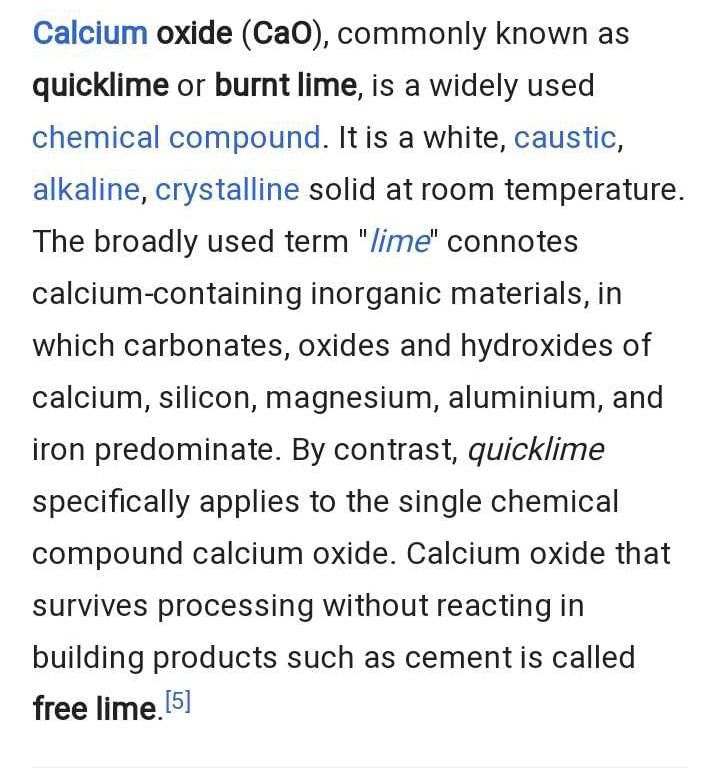Class 10 Exam > Class 10 Questions > Chemical formulae for quick lime with definit...
Start Learning for Free
Chemical formulae for quick lime with definition ?
Most Upvoted Answer
Chemical formulae for quick lime with definition ?

Community Answer
Chemical formulae for quick lime with definition ?
Chemical Formulae for Quick Lime
Definition of Quick Lime
Quick lime, also known as burnt lime or calcium oxide, is a white or grayish-white solid that is produced by heating limestone or seashells at high temperatures. It is highly reactive and can react with water to form slaked lime or calcium hydroxide.
Chemical Formulae
The chemical formula for quick lime is CaO, which means it is composed of one calcium atom and one oxygen atom.
Production of Quick Lime
Quick lime is produced by heating limestone or seashells in a kiln at temperatures of around 900-1000°C. During this process, the calcium carbonate in the limestone or seashells decomposes to form calcium oxide and carbon dioxide gas. The carbon dioxide gas is then released into the atmosphere, while the calcium oxide is collected as quick lime.
Properties of Quick Lime
Quick lime has several important properties, including:
- Highly reactive: Quick lime is highly reactive and can react with water to form slaked lime or calcium hydroxide.
- Strongly alkaline: Quick lime is strongly alkaline and can cause burns and irritation if it comes into contact with skin or eyes.
- Hygroscopic: Quick lime is hygroscopic, meaning it can absorb moisture from the air and form a slurry or paste.
- Insoluble in water: Quick lime is insoluble in water, but it can react with water to form slaked lime.
Uses of Quick Lime
Quick lime has several important uses, including:
- Production of cement: Quick lime is a key component in the production of cement, where it is used to convert clay and limestone into clinker.
- Water treatment: Quick lime is used to treat water and wastewater by adjusting the pH and removing impurities.
- Steel production: Quick lime is used in the steel industry to remove impurities from iron ore and to form slag.
- Agriculture: Quick lime is used in agriculture to neutralize acidic soils and to provide calcium for plant growth.
- Chemical production: Quick lime is used in the production of chemicals such as calcium carbide, calcium hypochlorite, and calcium stearate.

|
Explore Courses for Class 10 exam
|

|
Similar Class 10 Doubts
Chemical formulae for quick lime with definition ?
Question Description
Chemical formulae for quick lime with definition ? for Class 10 2025 is part of Class 10 preparation. The Question and answers have been prepared according to the Class 10 exam syllabus. Information about Chemical formulae for quick lime with definition ? covers all topics & solutions for Class 10 2025 Exam. Find important definitions, questions, meanings, examples, exercises and tests below for Chemical formulae for quick lime with definition ?.
Chemical formulae for quick lime with definition ? for Class 10 2025 is part of Class 10 preparation. The Question and answers have been prepared according to the Class 10 exam syllabus. Information about Chemical formulae for quick lime with definition ? covers all topics & solutions for Class 10 2025 Exam. Find important definitions, questions, meanings, examples, exercises and tests below for Chemical formulae for quick lime with definition ?.
Solutions for Chemical formulae for quick lime with definition ? in English & in Hindi are available as part of our courses for Class 10.
Download more important topics, notes, lectures and mock test series for Class 10 Exam by signing up for free.
Here you can find the meaning of Chemical formulae for quick lime with definition ? defined & explained in the simplest way possible. Besides giving the explanation of
Chemical formulae for quick lime with definition ?, a detailed solution for Chemical formulae for quick lime with definition ? has been provided alongside types of Chemical formulae for quick lime with definition ? theory, EduRev gives you an
ample number of questions to practice Chemical formulae for quick lime with definition ? tests, examples and also practice Class 10 tests.

|
Explore Courses for Class 10 exam
|

|
Signup for Free!
Signup to see your scores go up within 7 days! Learn & Practice with 1000+ FREE Notes, Videos & Tests.


























